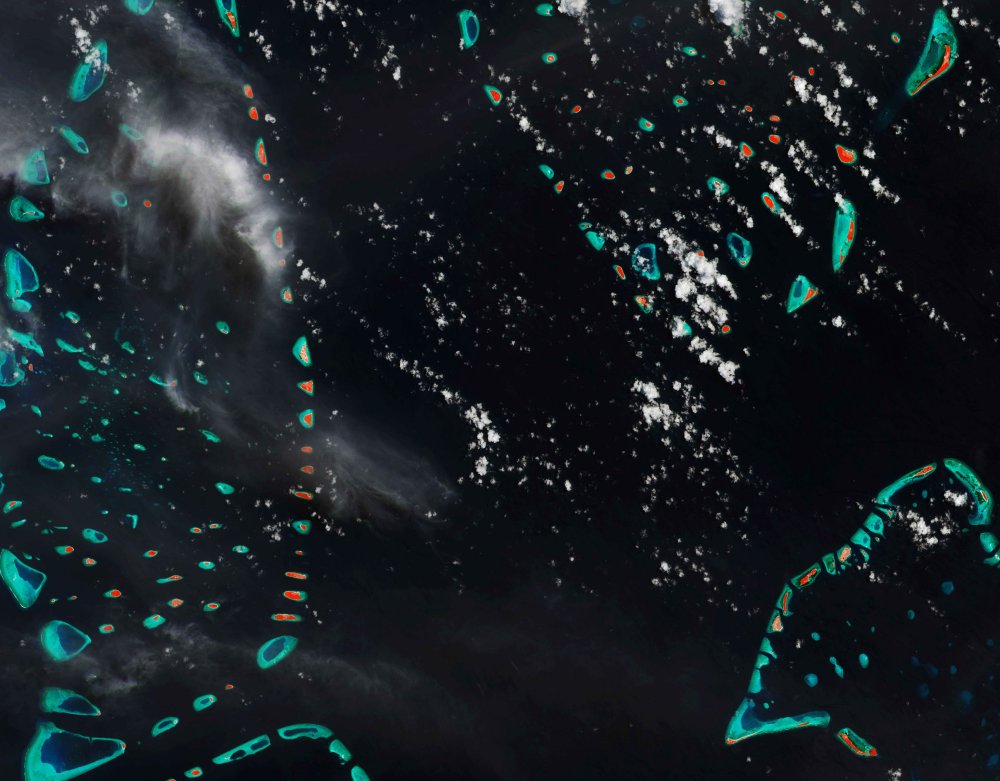Il satellite Sentinel-2 del programma europeo Copernicus in occasione della settimana di San Valentino ci trasporta su alcuni dei gioielli delle Maldive. Le Maldive – considerate probabilmente una tra le destinazioni più romantiche al mondo - si trovano nell’Oceano Indiano circa 700 km a sud-ovest di Sri Lanka. La nazione è formata da oltre 1000 isole coralline, distribuite tra più di 20 atolli a forma di anello.
Nell’immagine si può osservare un certo numero di queste piccole isole, con tonalità turchesi che raffigurano basse acque chiare punteggiate da barriere coralline, mentre il colore rosso evidenzia la vegetazione sulla terraferma.
Sono visibili differenti formazioni nuvolose, la cui particolare aspetto è dovuto alle differenti quote a cui si trovano rispetto al livello del mare.
Così come spesso accade per molte isole di bassa altitudine, le Maldive sono particolarmente vulnerabili all’innalzamento del livello del mare. In effetti, le Maldive sono ritenute essere il luogo più piatto della Terra, con assenza terreni che superano i 3 m e circa l’ 80% di essi che presentano un’altezza inferiore ad 1 m. E' bene ricordare che i rilevamenti satellitari hanno mostrato che nell’arco degli ultimi cinque anni il livello globale degli oceani è cresciuto – in media- di 4.8 mm l’anno, confermando così che l’innalzamento dei mari costituisce un problema reale per questi gioielli di isole.
Con la promessa di spiagge di sabbia candida, acque oceaniche azzurre e barriere coralline questo rifugio romantico attira oltre 600 000 turisti ogni anno. Mentre da un lato il turismo risulta di estrema importanza per l’economia nazionale, lo sviluppo di queste isole incontaminate crea anche forme di pressione, dovute ad esempio alla necessità di garantire un adeguato approvvigionamento di acqua potabile, al trattamento delle acque reflue ed a potenziali forme di inquinamento dell’oceano. Altri problemi ambientali che le Maldive devono affrontare riguardano la perdita del habitat di specie minacciate di estinzione, nonchè i danni causati alle barriere coralline.
Indubbiamente le Maldive costituiscono un fragile sistema, ma anche uno dei più bei luoghi del nostro pianeta, un posto da amare e di cui avere cura ora ed in futuro. Il giorno di San Valentino ci ricorda il tema dell’amore e certamente quest’anno e negli anni a venire sarà buona cosa ricordarci di amare il nostro pianeta.
Questa immagine è stata acquisita il 26 agosto 2015.
Scarica immagine MediumRes (5,06 MB - .JPG)
Scarica Immagine HighRes (39,66 MB - .TIF)
---
Jewels of the Maldives
Copernicus Sentinel-2 brings you some of the jewels of the Maldives for Valentine’s week. Arguably one of the most romantic destinations in the world, the Maldives lie in the Indian Ocean about 700 km southwest of Sri Lanka. The nation is made up of more than 1000 coral islands spread across more than 20 ring-shaped atolls.
A number of these little islands can be seen in the image, with the turquoise colours depicting clear shallow waters dotted by coral reefs and the red colours highlighting vegetation on land.
Different cloud formations can also be seen, the difference in appearance is likely to be due to the different height above the surface.
Like many low-lying islands, the Maldives are particularly vulnerable to sea-level rise. In fact, the Maldives are reported to be the flattest country on Earth, with no ground higher than 3 m and 80% of the land lying below 1 m. With satellite records showing that over the past five years, the global ocean has risen, on average, 4.8 mm a year, rising seas are a real threat to these island jewels.
With the promise of white sandy beaches, azure ocean waters and coral reefs, this romantic getaway draws more than 600 000 tourists every year. While tourism is extremely important for the national economy, development on these pristine islands create pressures, such as ensuring an adequate supply of freshwater, treating sewage and potential pollution entering the ocean. Other environmental issues facing the Maldives include the loss of habitats of endangered species and the damage to the coral reefs.
The Maldives are undoubtedly fragile but one of the most beautiful places on the planet, and a place to be loved and cherished now and in the future. Valentine’s Day reminds us of love and maybe this year and beyond it’s good to remember to love our planet.
This image was captured on 26 August 2015.
(Fonte: ESA - Image of the week: "Jewels of the Maldives". Traduzione: Gianluca Pititto)
Copia qui lo "short link" a questo articolo
www.geoforall.it/{sh404sef_shurl}




